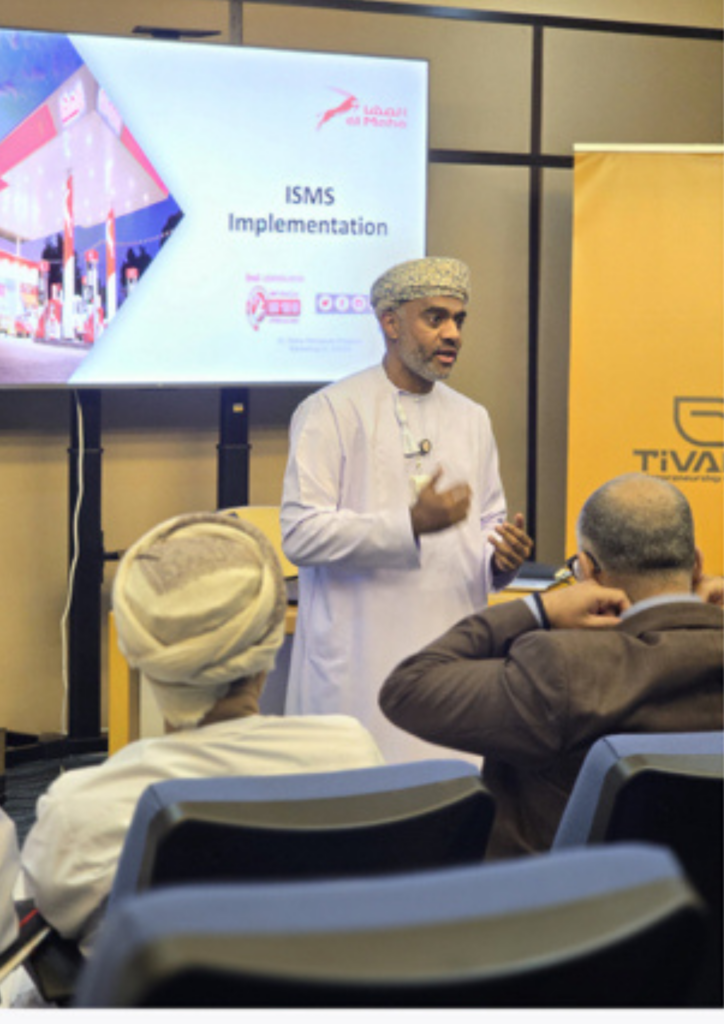The electronic security sector is the backbone of safeguarding digital assets, critical infrastructure, and sensitive information in today’s interconnected world. As cyber threats become more sophisticated and pervasive, the need for a structured governance system has never been greater. Such systems are pivotal for ensuring accountability, establishing clear roles and responsibilities, and aligning security strategies with organizational objectives and regulatory frameworks. In this interview, we delve into the significance of governance in the electronic security sector. We will explore how robust governance frameworks can enhance resilience, promote compliance, and foster a proactive approach to risk management. Join us as we uncover insights from our expert, who will shed light on best practices, common challenges, and the transformative impact of governance on cybersecurity operations.
Biography: Talal Al Asmi
Talal Al Asmi is a seasoned IT Auditor with over 20 years of experience in Information Security, including 17 years in leadership and strategic positions. He is currently serving in a critical IT Auditor role at ALMAHA Petroleum Products Marketing Co. SAOG, a company with over 400 employees. Since joining ALMAHA in 2021, Talal has been instrumental in building and implementing comprehensive Information Security strategies, including the development of an Information Security Management System (ISMS) aligned with ISO 27001 standards.
Throughout his career, Talal has held several high-profile roles such as Head of GRC, Security Transformation Lead, Lead Security Architect, and Head of IT Security Compliance. His expertise has been pivotal in delivering significant security projects and initiatives, including the creation of the MOE Information Security strategies, which involved indefinite asset management, risk assessment, and strategic management objective definition.
Talal is the visionary behind several innovative projects, including the Cyber Safe Project and the Blackmail Campaign, both of which have contributed to enhancing security awareness and culture. He also spearheaded the proposal to establish a Security Operations Centre (SOC) for the Ministry of Education (MOE), demonstrating his forward-thinking approach to cybersecurity.
In addition to his practical achievements, Talal has made substantial cost savings, such as saving more than 500,000 OMR in one year for Ministry of Education. His commitment to capacity building is evident through his efforts to develop and enhance the skills of his team.
Talal holds a Master’s Degree in Network Security and Digital Forensics and has continuously honed his skills by qualifying in more than five top-rated internationally recognized professional exams, including CISM, CRISC, CISA, CDPSE, IFRS16, CSNA, and CSNE.
With a passion for innovation, entrepreneurship, IT security, and business strategy, Talal Al Asmi is recognized as a leader in the field, driving forward the security posture of the organizations he serves. His strategic vision and leadership continue to influence the cybersecurity landscape in the region.

The Interview :
Introduction
1. Introduction to Governance in Electronic Security
Electronic security is use of electronic systems and devices to protect people, property, information, and assets from threats such as theft, intrusion, or unauthorized access. It involves the integration of various technologies to create systems that monitor, detect, and respond to security breaches. Electronic security can encompass a wide range of applications, from residential and commercial security to high-tech systems used by government and military agencies.
2. Legal and Legislative Environment
- How effective do you believe the current legal and legislative frameworks are in supporting the implementation of electronic security governance?
Current frameworks like GDPR and NIST are effective but may struggle to keep up with rapidly evolving threats and technologies. They provide solid guidelines but lack flexibility and global harmonization.
- Can you provide examples of specific laws or regulations that have significantly impacted the governance system in electronic security?
GDPR: Strengthens data protection and compliance. NIST Cybersecurity Framework: Provides comprehensive risk management guidelines. – HIPAA: Mandates strict security controls for healthcare data.
- What gaps, if any, do you see in the current legislative environment concerning electronic security governance?
Lack of consistency across international laws and the slow pace of regulatory adaptation to new technologies (e.g., AI, IoT) are key gaps. More proactive, adaptable regulations are needed.
3. Challenges in Implementation
- What are the main challenges organizations face when implementing a governance system in the electronic security sector?
Complexity of Regulations: Navigating multiple, often conflicting, frameworks. Resource Constraints: Sufficient funding, tools, and expertise may be lacking. Integration: Aligning security governance with existing systems. – Resistance to Change: Employees may resist new policies.
- How do different sectors (e.g., finance, healthcare, government) face unique challenges in establishing governance systems?
Finance: Strict regulatory compliance and financial fraud risks. Healthcare: Balancing data protection with the need for accessible patient information. Government: Managing high-stakes data and public scrutiny.
- What role does organizational culture play in the successful implementation of governance in electronic security?
A security-conscious culture ensures that governance is respected and applied consistently across all levels, with leadership setting the tone for engagement and compliance.
4. Best Practices and Case Studies
- Can you share some best practices for implementing a governance system in electronic security that you have encountered or implemented?
Holistic Risk Management: Integrate both physical and cybersecurity. Clear Responsibilities: Assign specific roles for governance tasks. Regular Audits: Continuously evaluate security posture and compliance. Stakeholder Engagement: Involve all departments early for buy-in.
- Are there any case studies or real-world examples where effective governance systems have significantly enhanced electronic security?
Target: Post-breach, Target revamped its governance system with continuous monitoring and third-party risk management, improving its security. DoD: The U.S. The Department of Defense uses the NIST framework to secure sensitive defense data.
- How do you measure the success of a governance system in the electronic security sector?
Through metrics like compliance rates, incident response times, risk reduction, and audit outcomes.
5. Integration with Legal and Legislative Frameworks
- How can organizations better align their governance systems with existing legal and legislative frameworks?
By regularly consulting with legal teams to ensure that governance policies stay compliant with laws. Using automated compliance tools can also help maintain alignment.
- What strategies can be employed to ensure compliance with legal requirements while maintaining flexibility in governance?
Modular Governance: Build adaptable systems that evolve with changing regulations. Automation: Use tools to track compliance and reduce manual effort. Consult Legal Advisors: Ensure legal teams are involved in governance updates.
- How do you foresee the evolution of legal and legislative frameworks impacting governance in the electronic security sector?
Expect more stringent, proactive regulations that focus on continuous risk management and the integration of data privacy protections across sectors.
6. The Role of Leadership
- What role do CEOs and other top-level executives play in the successful implementation of governance systems in electronic security?
Leadership must prioritize security, allocate resources, and ensure that governance becomes part of the organizational culture. Their commitment is crucial for success.
- How important is it for leadership to prioritize investment in electronic security governance, and what are the potential risks if they do not?
Without leadership support, governance initiatives may lack sufficient resources, leading to inadequate protection and higher risk exposure.
- How can leadership foster a culture that supports strong governance practices in electronic security?
By setting clear security priorities, providing ongoing training, and rewarding compliance, leadership can instill a culture that embraces security as a core value.

7. Future Outlook
- What trends do you anticipate in the future of governance systems within the electronic security sector?
Automation: More systems will incorporate AI for proactive threat detection and risk management. Zero Trust: Expect wider adoption of Zero Trust models focusing on continuous verification. Integration of AI and Data Analytics: AI will help analyze risks and optimize governance processes in real-time.
- How do you see emerging technologies (e.g., AI, blockchain) influencing the governance of electronic security in the future?
AI: Will improve threat prediction and incident response. Blockchain: Will enhance security by providing tamper-proof audit trails. Quantum Computing: Will require new governance frameworks for quantum-resistant encryption.
- What advice would you give to organizations looking to strengthen their governance systems in the face of evolving threats and regulations?
Adopt a proactive, adaptable approach to governance. Invest in continuous training, leverage automation, and engage cross-functional teams to ensure comprehensive, future-proof security.
8. Resolving Conflicts and Challenges
- How can organizations resolve conflicts that arise between cybersecurity teams and other departments during the implementation of a governance system?
Promote collaboration, ensure clear communication, and align on shared security goals. Leadership support is essential for mediating conflicts.
- What are some of the most common mistakes organizations make when establishing governance systems, and how can they be avoided?
Lack of leadership buy-in: Governance systems will fail without executive support. Overcomplexity: A phased, manageable approach is better than trying to implement everything at once. Neglecting training: Ongoing education is crucial for effective governance.
- How can external stakeholders, such as regulators and legal advisors, assist in overcoming challenges in governance implementation?
Regulators provide guidance on compliance. Legal advisors help ensure governance frameworks meet regulatory standards and Auditors offer independent assessments, highlighting weaknesses and gaps.
9. Conclusion
- In your opinion, what is the single most important factor in ensuring the success of a governance system in the electronic security sector?
The single most important factor is strong leadership commitment. Governance frameworks need to be backed by consistent support from senior management, ensuring that resources, time, and attention are allocated to building a robust security culture. Leadership should communicate the importance of governance across all levels of the organization, making it a priority for everyone.
- How would you summarize the importance of a robust governance system in the context of today’s digital landscape?
In today’s interconnected and increasingly digital world, a robust governance system is vital for safeguarding organizations from the wide array of threats they face. Effective governance ensures that security is a foundational part of business operations, aligns risk management with organizational objectives, ensures compliance with regulatory frameworks, and enables resilience in the face of cyber and physical threats. Without it, organizations risk exposure to breaches, financial loss, and reputational damage.
- What final thoughts or recommendations would you offer to organizations looking to implement or improve their governance systems in electronic security?
Start with a clear framework by understanding the core elements of governance policy, risk assessment, compliance, roles, and incident response. Focus on continuous improvement as Governance isn’t a one-time project but an ongoing process that requires regular updates, training, and audits to stay effective. Leverage technologies like automation, AI, and analytics to support and improve governance efforts, making them more efficient and adaptive to emerging threats. And lastly, Involve the entire organization to ensure that cybersecurity and governance are embedded into the organization’s culture, not just seen as IT issues. Everyone has a role in maintaining security.




